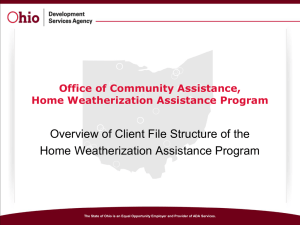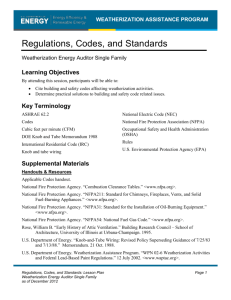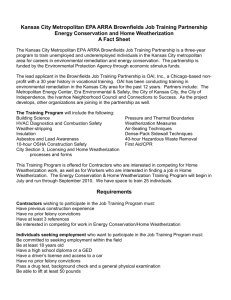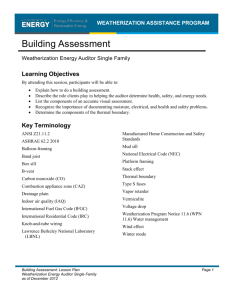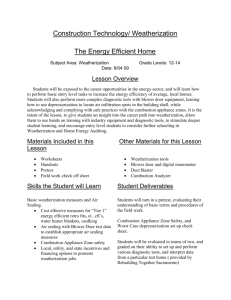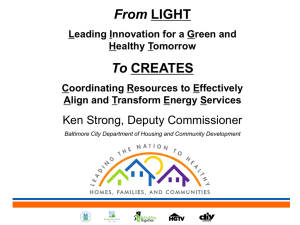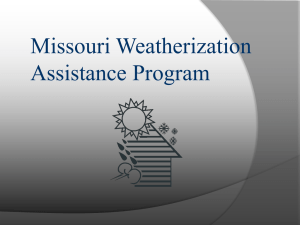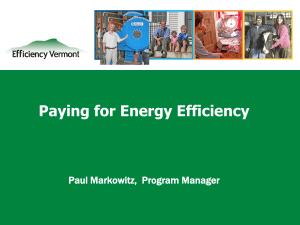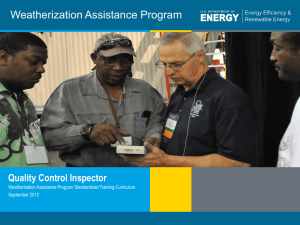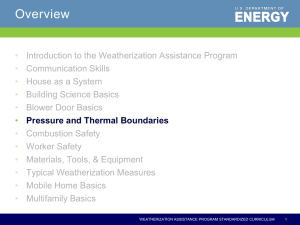Regulations and Standards - Weatherization Assistance Program
advertisement
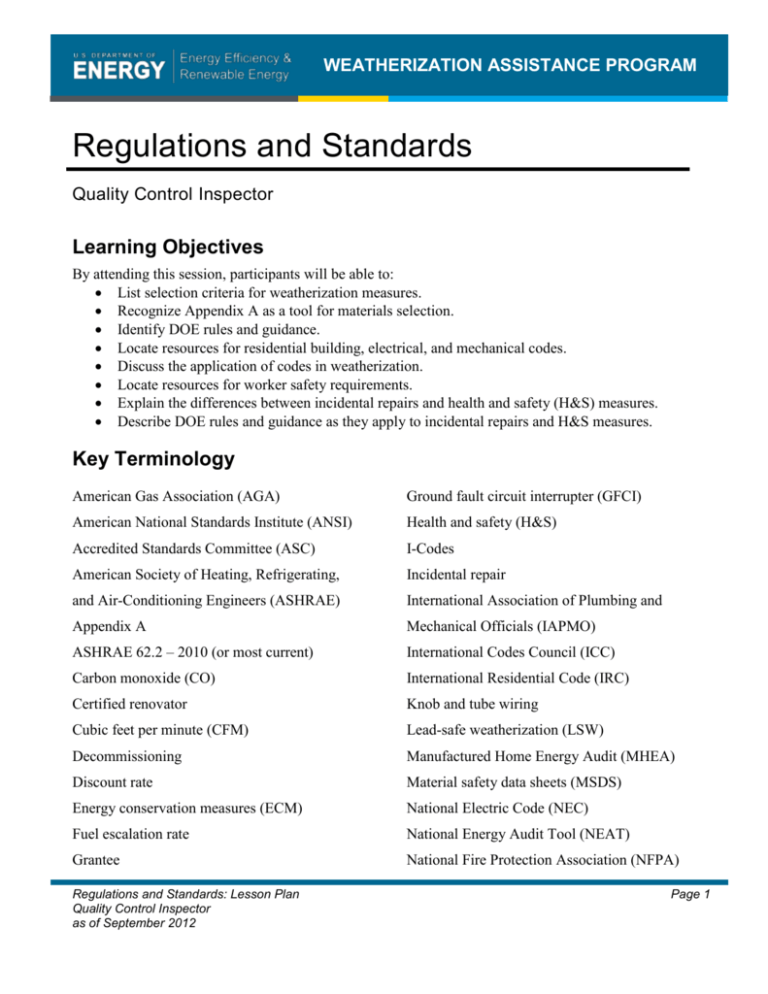
WEATHERIZATION ASSISTANCE PROGRAM Regulations and Standards Quality Control Inspector Learning Objectives By attending this session, participants will be able to: List selection criteria for weatherization measures. Recognize Appendix A as a tool for materials selection. Identify DOE rules and guidance. Locate resources for residential building, electrical, and mechanical codes. Discuss the application of codes in weatherization. Locate resources for worker safety requirements. Explain the differences between incidental repairs and health and safety (H&S) measures. Describe DOE rules and guidance as they apply to incidental repairs and H&S measures. Key Terminology American Gas Association (AGA) Ground fault circuit interrupter (GFCI) American National Standards Institute (ANSI) Health and safety (H&S) Accredited Standards Committee (ASC) I-Codes American Society of Heating, Refrigerating, Incidental repair and Air-Conditioning Engineers (ASHRAE) International Association of Plumbing and Appendix A Mechanical Officials (IAPMO) ASHRAE 62.2 – 2010 (or most current) International Codes Council (ICC) Carbon monoxide (CO) International Residential Code (IRC) Certified renovator Knob and tube wiring Cubic feet per minute (CFM) Lead-safe weatherization (LSW) Decommissioning Manufactured Home Energy Audit (MHEA) Discount rate Material safety data sheets (MSDS) Energy conservation measures (ECM) National Electric Code (NEC) Fuel escalation rate National Energy Audit Tool (NEAT) Grantee National Fire Protection Association (NFPA) Regulations and Standards: Lesson Plan Quality Control Inspector as of September 2012 Page 1 WEATHERIZATION ASSISTANCE PROGRAM NFPA 31, “Standard for the Installation of OilBurning Equipment” NFPA 54, “National Fuel Gas Code” NFPA 211, “Standard for Chimneys, Fireplaces, Vents, and Solid Fuel-Burning Appliances” Occupational Safety and Health Administration (OSHA) Personal protective equipment (PPE) Present value (PV) Savings-to-investment ratio (SIR) Standards for conformance Supplemental Materials Handouts & Resources “12 Steps to Lead Safety.” WxTV. Montana Weatherization Training Center. <www.wxtvonline.org>. Applicable Codes Handout. Appropriate ASHRAE guidelines. Code of Federal Regulations, Title 10 – Energy, Part 440 – Weatherization Assistance for Low-Income Persons (10 CFR 440). <http://www.waptac.org/Rules-and-Regulations/FederalRegulations.aspx>. Code of Federal Regulations, Title 10 – Energy, Part 440 – Weatherization Assistance for Low-Income Persons (10 CFR 440), Appendix A. <http://www.waptac.org/Rules-and-Regulations/FederalRegulations.aspx>. MSDS for two-part foam. National Institute for Occupational Safety and Health website. <www.cdc.gov/niosh>. Regulations and Standards Quiz. Regulations and Standards Quiz Answer Key. Savings-to-Investment Ratio calculator with PV function. Savings-to-Investment Ratio Worksheet. U.S. Department of Energy. Weatherization Assistance Program. “WPN 09-6 Lead Safe Weatherization (LSW) - Additional Materials and Information.” 22 Jan. 2009. <www.waptac.org>. U.S. Department of Energy, Seattle Regional Office and Energy OutWest. Energy OutWest Weatherization Field Guide. 2005. Copyright Saturn 2009. <www.azcommerce.com>. U.S. Department of Energy, Weatherization Assistance Program, Midwest Regional Field Office. Midwest Weatherization Best Practices Field Guide. May 2007. <www.karg.com>. U.S. Department of Energy, Weatherization Assistance Program. Southeast Weatherization Field Guide. 2002. Copyright Saturn 2002. Page 2 Regulations and Standards: Lesson Plan Quality Control Inspector as of September 2012 WEATHERIZATION ASSISTANCE PROGRAM U.S. Department of Energy. Hot Climate Initiative. Combustion Appliance Safety & Efficiency Testing. U.S. Department of Energy. Memorandum. “Knob-and-Tube Wiring: Revised Policy Superseding Guidance of 7/25/83 and 7/13/88.” Oct. 21, 1988. U.S. Department of Energy. Weatherization Assistance Program. “WPN 02-6 Weatherization Activities and Federal Lead-Based Paint Regulations. Attachment B: Lead Paint Decision Chart.” 12 July 2002. <www.waptac.org>. U.S. Department of Energy, Weatherization Assistance Program, WPN 11-6. Health and Safety Guidance. January 12, 2011. <www.waptac.org>. U.S. Department of Energy, Weatherization Assistance Program, WPN 12-1. Program Year 2012 Weatherization Grant Guidance. January 31, 2012. <www.waptac.org>. [Note: Use most recent program year guidance.] U.S. Department of Energy, Weatherization Assistance Program, WPN 12-9. Incidental Repair Measure Guidance. June 27, 2012. <www.waptac.org>. U.S. Department of Energy, Weatherization Assistance Program, WPN 12-9. Incidental Repair Measure FAQ. June 27, 2012. <www.waptac.org>. U.S. Department of Labor. Occupational Safety and Health Administration. “Fall Protection Tips QuickCard™.” <www.osha.gov>. Online Platform Lessons Use these online interactive training modules as prerequisites before students attend the course, or as in-class computer lab sessions. Users must first create an account at www.nterlearning.org to access the lesson. a- 8.2 ASHRAE 62.2 https://www.nterlearning.org/web/guest/course-details?cid=248 Relevant Standard Work Specifications 1.000 Health & Safety 3.000 Air Sealing 4.0000 Insulation 4.9901.1 Insulation – General Information on SPF 6.9901 Ventilation – Codes and Standards, Supplemental Ventilation Information Classroom Props and Activities Exercise: Compare Simple Payback and Simple SIR Discuss simple payback as it relates to SIR. Simple payback provides auditors with an estimate of whether a measure is close to cost-effective. SIR calculations using present value and fuel escalation rates are more accurate and must be applied within WAP. Regulations and Standards: Lesson Plan Quality Control Inspector as of September 2012 Page 3 WEATHERIZATION ASSISTANCE PROGRAM Conduct simple payback calculations on the board for the class to follow along. Assume replacing a refrigerator costs $300 and saves $25 dollars per year in electricity. The refrigerator has a simple payback of 12 years. Plugging those same numbers ($300 cost, $25 annual savings, and 12-year life) into a simple SIR calculation returns a value of exactly 1. Display the SIR Calculator spreadsheet tool. Input a variety of utility rates, installation costs, and estimated savings to illustrate how these factors influence SIR. Exercise: What is Required? While monitoring or inspecting, students may have to determine whether measures were installed in accordance with local codes. Slides 36 through 41 illustrate common weatherization work order requests. Distribute the Applicable Codes Handout. Divide the class into groups of three or four students. For each slide, give the groups 5 to 10 minutes to decide which codes/rules apply. Have students list any required actions and any needed calculations to size installed measures or equipment. Have each group list its answers on a flip chart. Compare answers and decide as a class on the correct response(s) to each situation. Suggested responses: Slide 36: Work order says, “Insulate over knob and tube wiring.” The NEC requires that all wiring junction boxes, not just knob and tube, be flagged before insulating over them. NEC 394.12 specifically forbids enveloping knob and tube wiring with thermal insulation. DOE policy allows insulating around knob and tube wiring if certain conditions are satisfied: All affected live knob and tube wiring is visually examined to see that it is in good condition and tested to see that the circuit voltage drop is less than 10%. The circuit breaker or fuse controlling the circuit is matched to the wire gauge. Correct amperage “S” type fuses are installed if the fuse panel has screw-in fuses. All affected circuits in walls are evaluated, not just visible wiring in attics or elsewhere. Slide 37: Work order says, “Add attic venting as necessary.” The International Residential Code 2012 requirement for attic venting states: Minimum net free ventilating area shall be 1/150 of the area of the vented space. Exception: The minimum net free ventilation area shall be 1/300 of the vented space provided one or more of the following conditions are met: In climate zones 6, 7, and 8, a class I or II vapor retarder is installed on the warm-in-winter side of the ceiling. Page 4 Regulations and Standards: Lesson Plan Quality Control Inspector as of September 2012 WEATHERIZATION ASSISTANCE PROGRAM At least 40% and not more than 50% of the required ventilating area is provided by ventilators located in the upper portion of the attic or rafter space. Assuming this home is in a northern climate and has a class I or II vapor barrier, we follow the 1/300 rule. Sloped ceiling area is included in the attic floor area for this calculation. Existing ventilation: Three 8 ft. x 26 ft. ceiling sections = 624 sq. ft./300 sq. ft. = 2.08 sq. ft. net free vent area required. (12 in. x 18 in.)/2 [screening blocks 1/2 of the free vent area] x 2 vents = 2 x (1 ft. x 1.5 ft.)/2 = 1.5 sq. ft. net free vent area existing. 0.58 sq. ft. additional net free vent area is needed. Choices faced by auditor and installers: Add one 8 in. x 10 in. vent to each end = 2 vents x (0.67 ft. x 0.83 ft.)/2 = 0.56 sq. ft. added net free vent area. Replace existing vents with 12 in. x 24 in. vents = 2 x (12 in. x 24 in.)/2 = 2 x (1 ft. x 2 ft.)/2 = 2 sq. ft. net free vent area. Replace existing vents with 14 in. x 24 in. vents = 2 x (1.17 ft. x 2 ft.)/2 = 2.34 sq. ft. net free vent area. Which is correct? Adding the 8 in. x 10 in. vents is the least expensive way to satisfy the code requirement, but it is usually cosmetically unacceptable. Replacing the existing vents with 12 in. x 24 in. vents creates a net free vent area that’s slightly under the code, but it’s probably close enough for most authorities. Replacing the existing vents with 14 in. x 24 in. vents creates a net free vent area that’s slightly over the code. It’s the safe choice. Slide 38: Work order says, “Replace bedroom window.” 2006 & 2009 IRC 310.1.2 & 3 require a minimum 20 in. wide by 24 in. high, 5.7 sq. ft. clear opening area, or 5.0 sq. ft. with direct grade-level access for upper-story bedroom egress windows, including habitable attics. Note: 24 in. x 20 in. = 3.34 sq. ft., meaning at least one dimension must be greater than the code minimum. Regulations and Standards: Lesson Plan Quality Control Inspector as of September 2012 Page 5 WEATHERIZATION ASSISTANCE PROGRAM 27 in. x 44 in. = 1,188 sq. in./144 sq. in. = 8.25 sq. ft., but the existing window is single hung, allowing only half the opening or 4.125 sq. ft. Q: Is the replacement window “grandfathered?” A: No. It must be an egress window. A casement window is the easy answer, but it won’t match the building style or appearance. The pictured double-hung unit is acceptable because both sashes tilt in, allowing almost the full sash area to be free of any obstruction. For a home built before 1978: Installers must be lead-safe certified by EPA and work must be supervised by a certified firm. This must be documented in the client file. Lead-safe work practices must be used. Slide 39: Work order says, “Replace attic hatch.” 2009 IRC 807.1 requires a minimum rough opening of 22 in. x 30 in. if the attic is larger than 30 sq. ft., and requires a minimum of 30 in. of headroom between the hatch opening and roof framing at least at one point. For a home built before 1978: Installers must be lead-safe certified by EPA and work must be supervised by a certified firm. This must be documented in the client file. Lead-safe work practices must be used. Slides 40, 41: Work order says, “Install new bath fan and control.” The NEC applies. All wiring must be done by a licensed electrician. Legally, a resident homeowner can wire his own home. Over the years, some Community Action Agency employees and contractors have convinced homeowners to “twist the screws and wirenuts” to save a few dollars. DO NOT DO THIS! The potential liability risks are too high. For homes built before 1978: Page 6 Installers must be lead-safe certified by EPA and work must be supervised by a certified firm. This must be documented in the client file. Lead-safe work practices must be used. Regulations and Standards: Lesson Plan Quality Control Inspector as of September 2012 WEATHERIZATION ASSISTANCE PROGRAM How do you determine the fan installed is acceptable? What is the appropriate fan CFM? ASHRAE 62.2-2010: Bath fan must be rated at 50 CFM. If used to satisfy indoor air quality, ventilation must provide 7.5 CFM/person (occupancy determined by number of bedrooms plus 1) plus 1% of the conditioned floor area in sq. ft. [7.5 CFM x (3+1)] + [0.01 x (12 ft. x 20 ft. + 16 ft. x 8 ft. + 16 ft. x 26 ft. + 16 ft. x 26 ft.)] = (7.5 x 4) + [0.01 x (240 sq. ft. + 128 sq. ft. + 416 sq. ft. + 416 sq. ft.)] = 30 + 0.01 x 1,100 sq. ft. = 30 + 11 = 41 CFM The fan should be set to deliver 41 CFM continuous, or 82 CFM, ½ hour on, and ½ hour off. Ask students to volunteer similar situations they regularly encounter, describing what code issues they encounter, what is usually done, and why. Class Overview Before beginning the section, ask students what they think the measure selection guidelines for WAP are. Keep a running list. Deliver the presentation to the class. This presentation focuses as much on pointing out resources as on providing new content. If you have Wi-Fi access, use the links in the PowerPoint presentation to show the websites listed. Distribute handouts when prompted in the speaker notes and for the class exercise. Use the presentation to introduce the guidelines for selecting and installing measures. Note if certain things mentioned by the students are not required or if restrictions apply that students did not mention. Reference weatherization program notices that define or explain health and safety measures and incidental repairs. Discuss how those should be incorporated into a weatherization project. Lead a class discussion using slides 22–30 on whether the pictured scenarios qualify as incidental repairs or health and safety measures or could possibly be classified as either. Regulations and Standards: Lesson Plan Quality Control Inspector as of September 2012 Page 7

